Common Types of Intervention to Address Market Failure
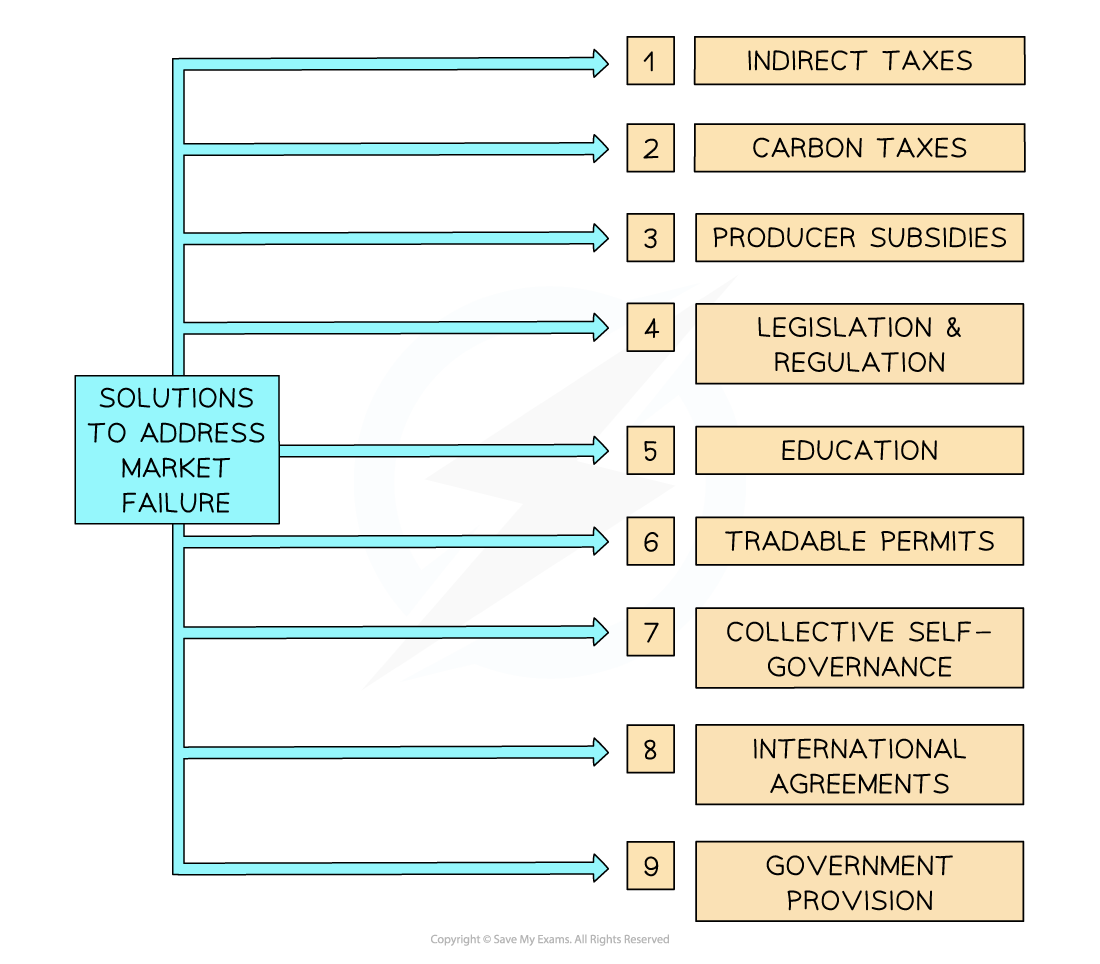
Methods used to address market failure
- Indirect (Pigouvian) taxes
A Pigouvian tax is a tax placed on a product with harmful side effects (named after Arthur Pigou), so as to increase its price and reduce the quantity demanded or the supply. Useful to address market failure where goods are over-provided
- Carbon taxes
A tax that producers who emit greenhouse gases have to pay. It sets a price on the carbon content forcing producers to pay for each ton of emissions. This raises their costs of production and should reduce supply. Useful to address market failure in markets where there's high a carbon footprint - Producer subsidies
The government gives firms a fixed amount of money per unit produced in order to lower production costs and/or increase output of the product. Useful to address market failure where goods are under-provided or consumed - Legislation and regulation
The government creates new laws (e.g. no single-use plastic bags) and then creates an agency (e.g. environment agency) to regulate those laws. Useful to address market failure where goods are over-provided or consumed - Education
The government funds advertising and education programs to educate the public on the dangers (or sometimes the benefits) of certain products e.g. anti smoking campaigns. Useful to address market failure caused by the existence of merit and demerit goods - Tradable permits
A mechanism which provides firms who emit greenhouse gases the option to buy a permit to pollute when it is required. This increases their costs of production and should reduce supply. If firms have permits that are no longer needed they are able to sell them to other firms - International agreements
These are useful for issues which are global in nature and require a globally coordinated response e.g. COP 27 agreements on climate change. Useful to address market failure where the tragedy of the commons is occurring and the global trade in demerit goods - Collective self-governance
Occurs when communities come together to take control of common pool resources in an attempt to deal with the negative externalities associated with their use - Government provision
Governments will often choose to directly provide certain goods/services (merit goods) in order to ensure that everyone in society has the same access. Useful to address market failure where goods are under-provided
Exam Tip
Market Failure is one of the most frequently examined topics in your exams. Expect 10 and 15-mark essays in Paper 1. Paper 2 may include definition questions, short explanations, diagram-only questions, diagrams with explanations: and/or an essay question.
Take your time working through this sub-topic ensuring you understand each diagram. If you can draw and explain the diagrams (solutions included), then you are fairly well prepared. If you can also evaluate each solution using a real-world example, then you are very well prepared.
Indirect (Pigouvian) Taxes
- A Pigouvian tax is a tax placed on a product with harmful side effects (named after Arthur Pigou), so as to increase its price and reduce the quantity demanded or the supply
- The aim of this tax is to make the individual or firm causing the externality to pay for it - the so-called polluter pays principle
- An indirect tax can be either ad valorem or specific
1. Specific Tax on a Negative Externality of Production
- Governments frequently tax firms that pollute or create external costs in production
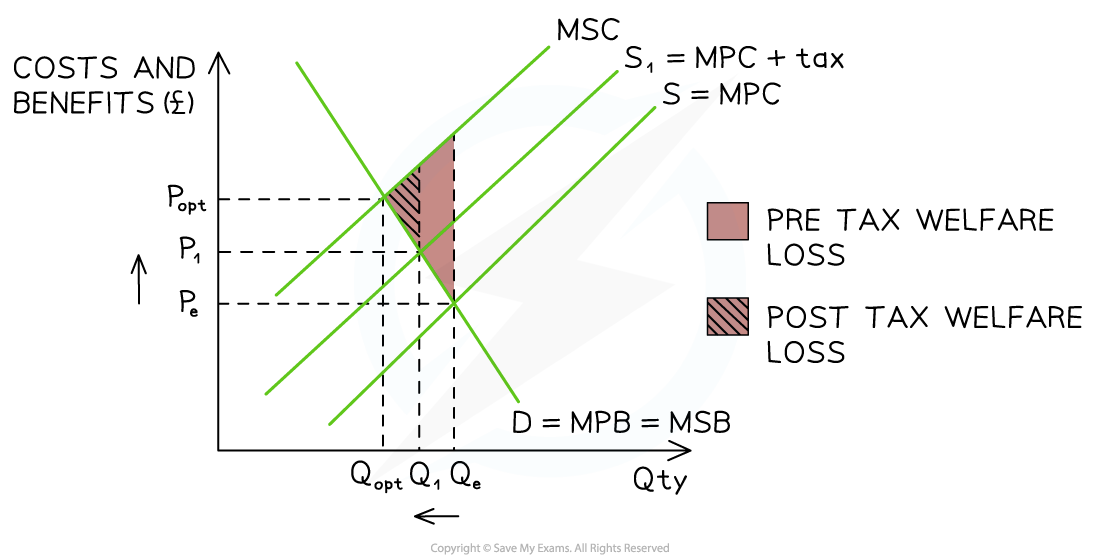
A diagram that shows the impact of a tax on a product that is over-provided in society. The tax reduces the welfare loss and moves production closer to the optimum level of production
Diagram Analysis
- The free-market equilibrium is at PeQe - where MSB = MPC
- Market failure exists as MSC > MSB at equilibrium
- Optimum level of output is at Qopt
- There is over-provision of this product equal to Qe - Qopt
- A specific tax shifts the supply curve left from S → S1 as it increases the costs of production
- The tax does not completely eradicate the welfare loss but moves the market closer to the optimum level of output (Qopt)
- The welfare loss has been reduced as shown in the diagram
- The new market equilibrium is at P1Q1
- This is a higher price and less output
- There is less over-provision and so less market failure
- The external costs have been reduced
2. Specific Tax on a Negative Externality of Consumption
- Governments frequently tax demerit goods such as cigarettes, alcohol, fatty foods, and polluting vehicles

A diagram that shows the impact of a tax on a product that is over-consumed in society. The tax reduces the welfare loss and moves consumption closer to the optimum level of production
Diagram Analysis
- The free-market equilibrium is at PeQe where MPB = MSC
- Market failure exists as MSC > MSB at equilibrium
- The optimum level of consumption is at Qopt
- There is over-consumption of this product equal to Qe - Qopt
- A specific tax shifts the supply curve left from S → S1 as it increases the costs of production
- The tax does not completely eradicate the welfare loss but moves the market closer to the optimum level of output (Qopt)
- The welfare loss has been reduced as shown in the diagram
- The new market equilibrium is at P1Q1
- This is a higher price and lower output
- There is less over-consumption and so less market failure
- The external costs have been reduced and the market is closer to the socially optimum level of output Qopt
Carbon Taxes
- A carbon tax is a tax on producers who emit greenhouse gases
- The tax sets a price on the carbon content forcing producers to pay for each ton of carbon dioxide (CO2) emissions
- The tax raises their costs of production and should reduce the supply
- This tax is useful in addressing market failure associated with atmospheric pollution

Canada has the highest carbon tax rates per ton of CO2 emissions in the world. The tax ranges from $15-$38 per ton of CO2 released - and is levied on all fossil fuels
Diagram Analysis
- The free-market equilibrium is at P1Q1 where MSB = MPC
- Market failure exists as MSC > MSB at equilibrium
- The optimum level of output is at Qopt
- There is over-provision of this product equal to Q1 - Qopt
- The carbon tax raises the cost of production for producers
- This causes the supply curve to shift left from S → S1, reducing the level of supply
- The tax does not completely eradicate the welfare loss but moves the market closer to the optimum level of output (Qopt)
- The welfare loss to society has been reduced
- The new market equilibrium is at P2Q2
- This is a higher price and lower output
- There is less over-provision and so less market failure
- The external costs have been reduced
Evaluating the use of Carbon Taxes to Address Market Failure
The Advantages and Disadvantages of Carbon Taxes
Advantages |
Disadvantages |
|
|
Subsidies
- Governments frequently use subsidies to encourage production/consumption of merit goods such as energy-efficient products, electric vehicles, healthcare, and education
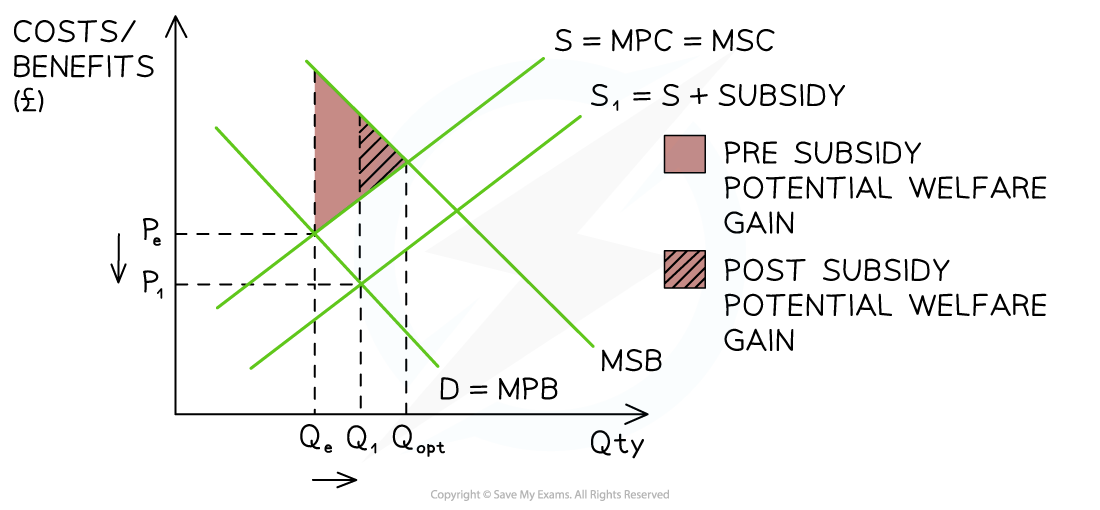
A diagram that shows the impact of a subsidy on a product that is under-consumed in society. The subsidy reduces the welfare loss and moves consumption closer to the optimum level
Diagram Analysis
- The free-market equilibrium is at PeQe where MPB = MSC
- Market failure exists as MSB > MSC at equilibrium
- The optimum level of output is at Qopt
- There is under-consumption of this product equal to Qopt - Qe
- A subsidy shifts the supply curve right from S → S1 as it lowers the costs of production
- It does not completely eradicate the potential welfare gain but moves the market closer to the optimum level of output (Qopt)
- The welfare loss has been reduced as shown in the diagram
- The new market equilibrium is at P1Q1
- This is a lower price and higher output
- There is less under-consumption and so less market failure
- Some of the external benefits available have been realised
Evaluating the use of Subsidies to Address Market Failure
The Advantages and Disadvantages of Producer Subsidies
Advantages |
Disadvantages |
|
|
Exam Tip
When evaluating any solution to market failure always consider the following points as each one could provide the framework for an evaluation paragraph in a 15-mark essay:
- The challenges involved in measuring externalities e.g. how is the monetary value of the external costs associated with smoking calculated? What should be included and what should be excluded in the calculation?
- The degree of effectiveness of the solution e.g. even though the data tells us that raising indirect taxes on demerit goods is the single most effective method, often the problem is so big that it requires a multi-faceted approach which includes taxation, legislation, regulation and education.
- The impacts on different stakeholders: the specific groups of people that any solution often impacts are young consumers, older consumers, rich consumers, poorer consumers, workers, firms, society, the environment and governments
Legislation & Regulation
- Governments create laws (legislation) to limit the harm caused by the external costs of consumption or production
- Regulatory agencies are then created to enforce the law and monitor that they are not broken
- Examples of regulators in the USA include The Environment Agency, The Food and Drug Administration (FDA), and The State Bank Regulators
- Examples of regulators in the USA include The Environment Agency, The Food and Drug Administration (FDA), and The State Bank Regulators
- Legislation can aim to influence the consumer side of the market (demand) or the producer side (supply) or both
1. Legislation aimed at the consumer side
- The legal age for drinking alcohol in the USA is 21 while it is only 18 in the UK
- The UK Government could change the legal age of alcohol consumption in order to reduce demand and the external costs associated with excessive alcohol consumption
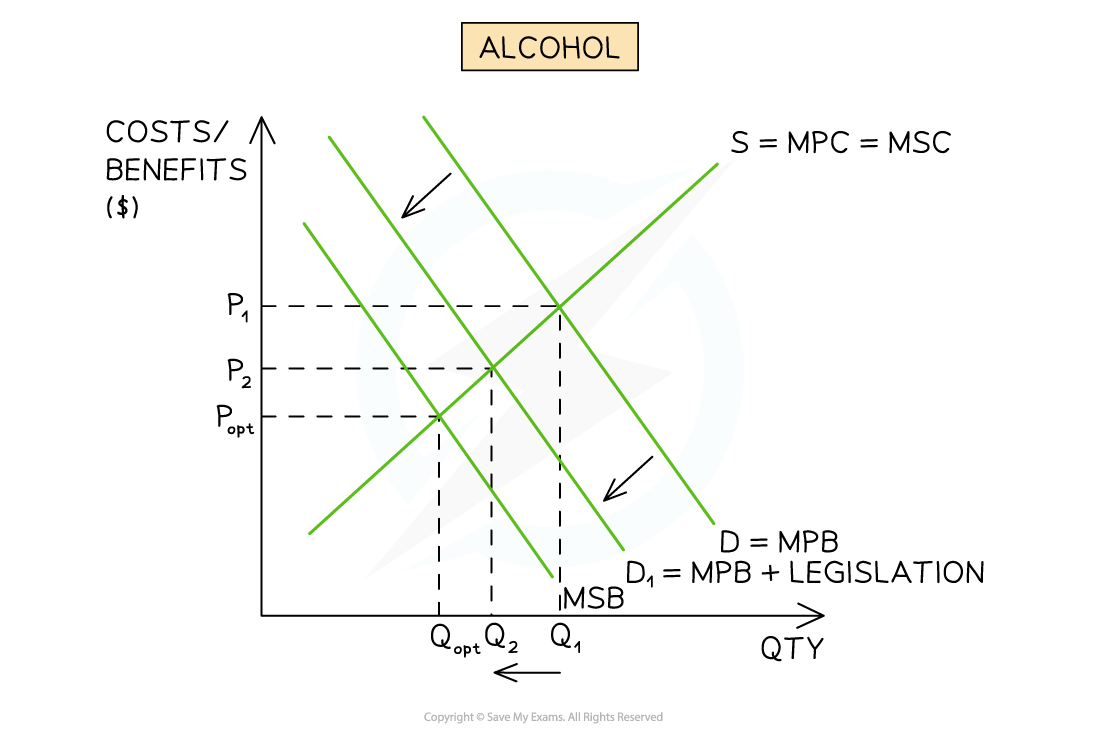
Legislation that changes the legal age of alcohol consumption will reduce the demand for alcohol thus decreasing the external costs of excessive drinking
Diagram Analysis
- The free-market equilibrium is at P1Q1 where MPB = MSC
- Market failure exists as MSC > MSB at equilibrium
- The optimum level of consumption is at Qopt
- There is over-consumption of this product equal to Q1 - Qopt
- The introduction of legislation that changes the legal age for alcohol consumption from 18 to 21 shifts the demand curve left from D → D1 as it reduces the effective population able to consume alcohol
- The legislation does not completely eradicate the welfare loss but moves the market closer to the optimum level of output (Qopt)
- The welfare loss has been reduced
- The new market equilibrium is at P2Q2
- This is a lower price and lower output
- There is less over-consumption and so less market failure
- The external costs have been reduced and the market is closer to the socially optimum level of output Qopt
2. Legislation aimed at the producer side
- Crayfish have been overfished off the coast of New Zealand (NZ)
- The NZ Minister of Fisheries (the regulator) is planning on closing certain crayfishing areas for a period of three years in order to allow the external costs (possible extinction in some areas) to be reduced
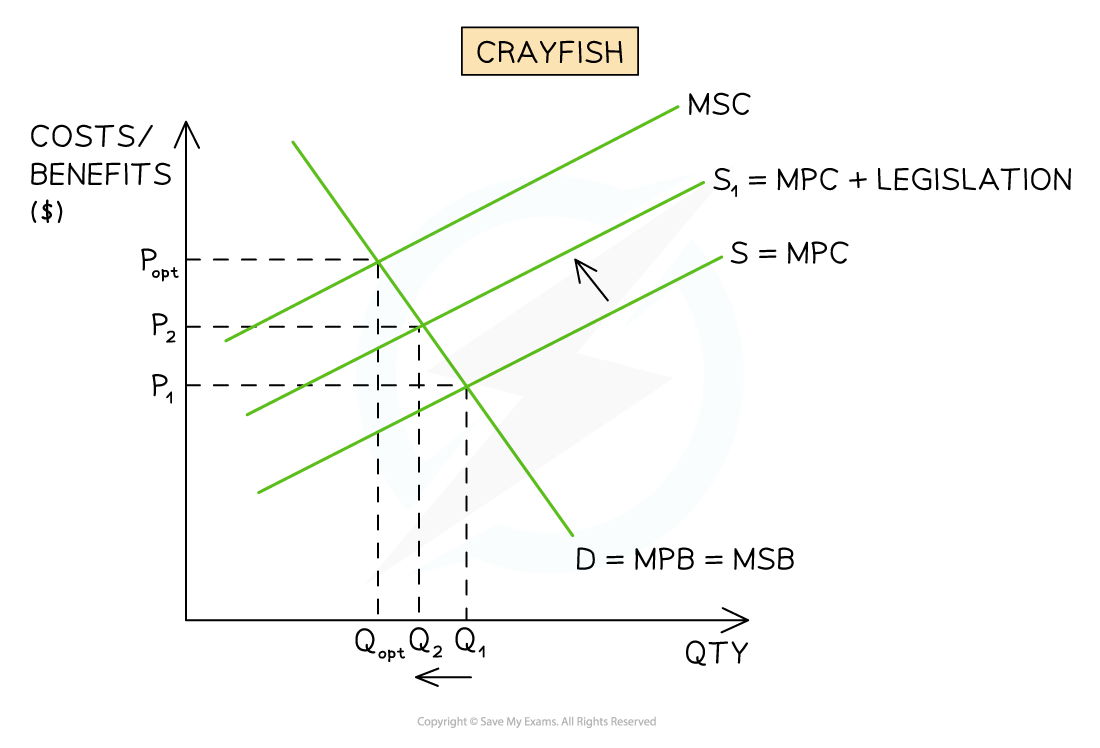
Legislation that reduces the potential supply of crayfish will help alleviate the external costs of overfishing
Diagram Analysis
- The free-market equilibrium is at P1Q1 where MSB = MPC
- Market failure exists as MSC > MSB at equilibrium
- The optimum level of supply is at Qopt
- There is over-supply of this product equal to Q1 - Qopt
- The introduction of legislation which stops crayfish from being caught in certain areas for 3 years will shift the entire supply curve left from S → S1
- The legislation does not completely eradicate the welfare loss but moves the market closer to the optimum level of output (Qopt)
- The welfare loss has been reduced
- The new market equilibrium is at P2Q2
- This is a higher price and lower output
- There is less over-supply and so less market failure
- The external costs have been reduced and the market is closer to the socially optimum level of output Qopt
Evaluating the use of Legislation & Regulation to Address Market Failure
The Advantages and Disadvantages of Legislation and Regulation
Advantages |
Disadvantages |
|
|
Education
- Raising awareness of the external benefits or costs associated with the consumption of a good/service is an effective long-term method of changing consumer behaviour
- Education campaigns happen in many different ways including social media advertising, television, newspaper and radio advertising, provision of brochures at Government-owned buildings (e.g. libraries)
1. Educating consumers on the benefits of merit goods
- Educating consumers on the benefits of merit goods will increase consumption of goods with external benefits (e.g. electric cars, energy-efficient heating systems)
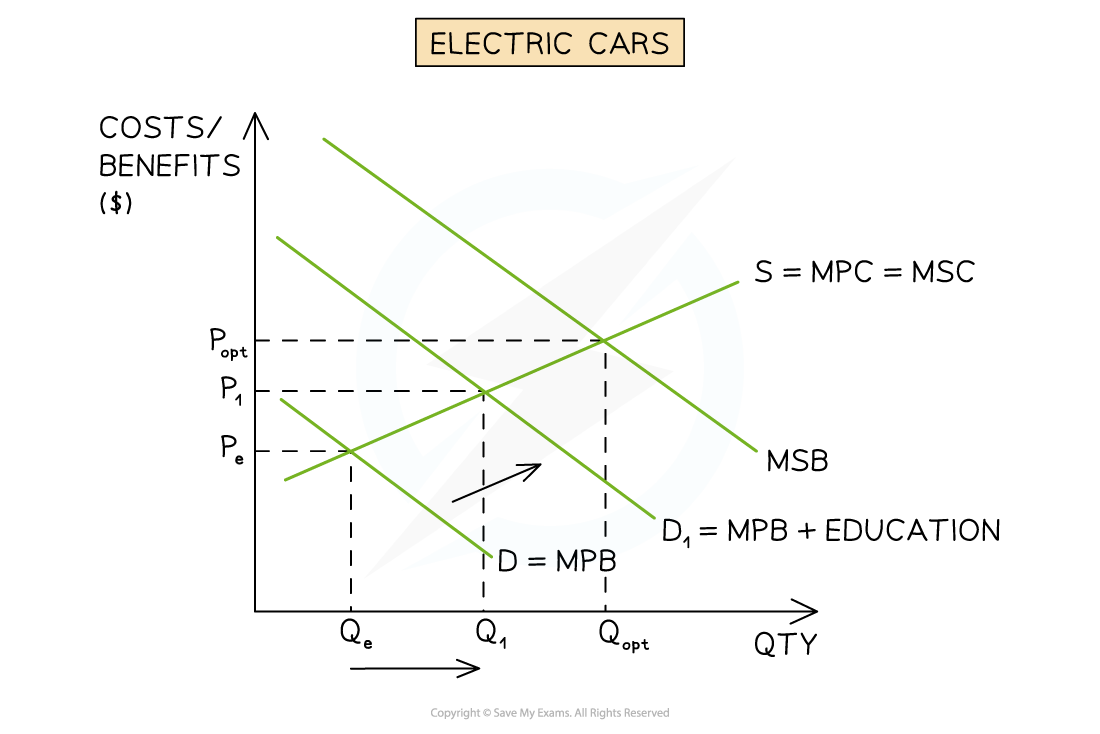
Educating consumers on the external benefits of electric cars will increase their marginal private benefit and demand will increase
Diagram Analysis
- The free-market equilibrium is at PeQe where MPB = MSC
- Market failure exists as MSB > MSC at equilibrium
- The optimum level of consumption is at Qopt
- There is under-consumption of electric cars equal to Qe - Qopt
- The introduction of an education campaign which promotes the external benefits of using electric cars (less CO2 pollution) shifts the demand curve right from D → D1 as consumers want to act positively towards emissions levels and climate change
- The education does not completely eradicate the welfare loss but moves the market closer to the optimum level of output (Qopt)
- The welfare loss has been reduced
- The new market equilibrium is at P1Q1
- This is a higher price and output
- There is less under-consumption and so less market failure
- The external benefits have been recognised and the market is closer to the socially optimum level of output Qopt
2. Educating consumers on the dangers of consuming demerit goods
- Educating consumers on the dangers of consuming demerit goods will decrease the consumption of goods with external costs (e.g. cigarettes, alcohol, drugs, single-use plastics)
- Demerit goods are usually addictive but even small decreases in consumption are still worthwhile
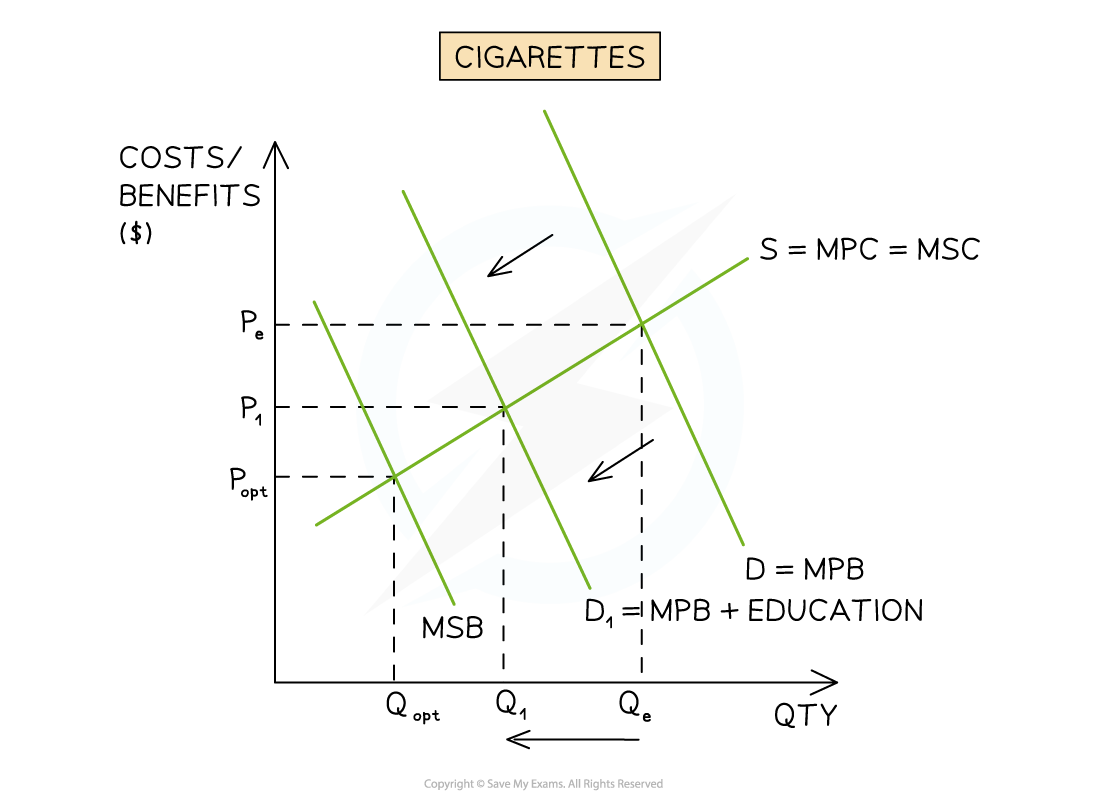
Educating consumers on the external costs of demerit goods will decrease their marginal private benefit and demand will decrease
Diagram Analysis
- The free-market equilibrium is at PeQe where MPB = MSC
- Market failure exists as MSC > MSB at equilibrium
- The optimum level of consumption is at Qopt
- There is over-consumption of cigarettes equal to Qe - Qopt
- The introduction of an education campaign which raises awareness of the external costs of smoking (e.g. passive smoking, cigarette stump pollution) shifts the demand curve left from D → D1 as consumers weigh their actions more carefully
- The education does not completely eradicate the welfare loss but moves the market closer to the optimum level of output (Qopt)
- The welfare loss has been reduced
- The new market equilibrium is at P1Q1
- This is a higher price and output
- There is less under-consumption and so less market failure
- The external benefits have been recognised and the market is closer to the socially optimum level of output Qopt
Evaluating the use of Education to Address Market Failure
The Advantages and Disadvantages of using Education
Advantages |
Disadvantages |
|
|
Exam Tip
Market Failure is one of the most frequently examined topics in your exams. Expect 10 and 15-mark essays in Paper 1. Paper 2 may include definition questions, short explanations, diagram-only questions, diagrams with explanations and an essay question.
Take your time working through this section ensuring you understand each diagram. If you can draw and explain the diagram, then you are fairly well prepared. If you can evaluate solutions using a real-world example, then you are very well prepared.